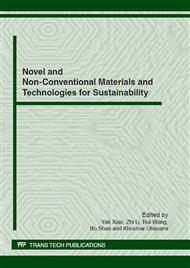[1]
R. J. Ball, A. El-Turki, W. J. Allen, G.C. Allen, The stress cycling of hydraulic lime mortars. Proceedings of Institution of Civil Engineers, Construction Materials. 160 2 (2007) 57-63.
DOI: 10.1680/coma.2007.160.2.57
Google Scholar
[2]
W. J. McCarter, S. Garvin, N. Bouzid, Impedance measurements on cement pastes. J. Mat. Sci. Lett. 7 (1988) 1056-7.
Google Scholar
[3]
W. J. McCarter, G. Starrs, T.M. Chrisp, T.M., Electrical monitoring methods in cement science, in: J. Benstead and P. Barnes (Eds), Structure and Performance of Cements, SPON, London, (2002).
Google Scholar
[4]
R. J. Ball et al, Impedance spectroscopy measurements to study physio-chemical processes in lime-based composites, submitted to Applied Physics A Materials: Science & Processing (2011).
Google Scholar
[5]
R.J. Ball, G.C. Allen, The measurement of water transport in porous materials using impedance spectroscopy. Journal of Physics D: Applied Physics. 43 (2010) 105503.
DOI: 10.1088/0022-3727/43/10/105503
Google Scholar
[6]
BS-EN 459-1, Building lime - Part 1: Definitions, specifications and conformity criteria, British Standard (2001).
Google Scholar
[7]
A. Moropoulou, A. Bakolas, E. Aggelakopoulou, Evaulation of pozzolanic activity of natural and artificial pozzolans by thermal analysis, Thermochimica Acta. 420 (2004) 135-140.
DOI: 10.1016/j.tca.2003.11.059
Google Scholar
[8]
D. D. Edwards, Sustainable Lime Mortars, thesis submitted to the University of Bristol for award of degree of Doctor of Philosophy in the Faculty of Science. Interface Analysis Centre (2009).
Google Scholar
[9]
E. Aggelakopoulou, A. Bakolas, A. Moropoulou, Properties of lime-metakaolin for the restoration of historic mansonries, Appl. Clay Sci. (2011), doi: 10. 1016/j. clay. 2011. 04. 005.
DOI: 10.1016/j.clay.2011.04.005
Google Scholar
[10]
M. Frias Rojas, M.I. Sanchez de Rojas, The effect of high curing temperature on the reaction kinetics in MK/lime and MK-blended cement matrices at 60°C, Cement and Concrete Research, 33 (2001) 643-649.
DOI: 10.1016/s0008-8846(02)01040-2
Google Scholar
[11]
A. Bakolas, E. Aggelakopoulou, A. Moropoulou, S. Anagnostopoulou, Evaluation of pozzolanic activity and physico-mechanical characteristics in metakaolin-lime pastes, Journal of Thermal Analysis and Calorimetry. 84 (2006) 157-163.
DOI: 10.1007/s10973-005-7262-y
Google Scholar
[12]
V.S. Ramachandran, R.M. Paroli, J.J. Beaudoin, A.H. Delgado., Handbook of thermal analysis of construction materials, William Andrew Publishing, Norwich, New York (USA), (2002).
Google Scholar
[13]
J.M. Khatib, S. Wild, Pore size distribution of metakaolin paste. Cement and Concrete Research. 26 10 (1996) 1545-1553.
DOI: 10.1016/0008-8846(96)00147-0
Google Scholar
[14]
M. Frias, J. Cabrera, Pore size distribution and degree of hydration of metakaolin-cement paste. Cement and Concrete Research. 30 (2000) 561-569.
DOI: 10.1016/s0008-8846(00)00203-9
Google Scholar
[15]
D.P. Almond, C.R. Bowen, Anomalous power law dispersion in AC conductivity and permittivity shown to be characteristics of microstructural electrical networks. Physical Review Letters. 92 15 (2004) 157601 1-4.
DOI: 10.1103/physrevlett.92.157601
Google Scholar


